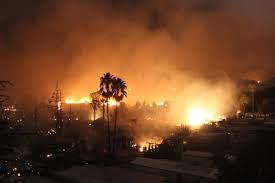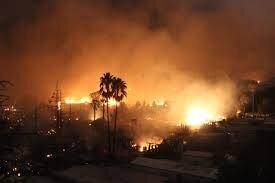The forecast this week is for beautiful blue skies with moderate temperatures and light, variable winds, but this is in stark contrast to the near 70 mph gusts and firestorm conditions that Sonoma County residents faced in 2017. Tuesday, Oct. 8 marks the two-year anniversary of the devastating Tubbs Fire that ripped through the Santa Rosa area, burning 36,807 acres, destroying 5,636 buildings in the process, and taking the lives of at least 23 individuals.
According to the Santa Rosa Press Democrat’s Pulitzer Prize-winning coverage of the fires, the incident began at 9:43 p.m. in the hills outside of Calistoga, north-east of Santa Rosa. Fueled by hot, dry Diablo winds, the fire spread rapidly, consuming approximately an acre a minute. By midnight, several neighborhoods in Santa Rosa were overcome by the firestorm, and the blaze jumped Highway 101 at 2 a.m., impacting Cleveland Ave. and devastating the Coffey Park neighborhood.
50,000 Sonoma County residents were forced to evacuate as the fires raced across the landscape. Fires started practically simultaneously in four northern California counties, overwhelming first responders and county officials. As crews worked to manage the blaze and develop a plan of action, residents fled to safety and the comfort of friends and family.
While the fires were eventually extinguished, the community was left with deep emotional scars and community-wide post traumatic stress disorder. Even those that did not experience physical loss are still affected, as survivors’ guilt and compassion for others cause some to suffer from mental health issues.
An unfortunate side-note to the wildfire story is the lack of affordable insurance for homeowners and renters in the county. Applicants are being denied coverage in many areas because the locations have now been classified as too risky to insure. As the New York Times reported, 1.7 million houses in California reside in areas deemed to be highly prone to wildfire. Declaring homes uninsurable makes it next to impossible to obtain financing for a loan, which leads to lower property values and declining revenues for municipal governments, as property taxes are tied to valuations.
The California FAIR Plan is an industry operated program that offers insurance to high-risk homeowners and renters, but online reviews are not favorable, with complaints of insufficient and dropped coverage combined with significant rate increases. The lack of available insurance coverage exposes Sonoma County residents to a high risk of loss and leaves many with little option but to look for sustainable housing elsewhere.
The unfortunate reality is that many homeowners and renters were uninsured or underinsured and were left unable to rebuild after the fire. Sonoma County was in the midst of a housing crisis even before the fires began, and the loss of homes caused this problem to be greatly exacerbated. According to the County of Sonoma’s official website, “before the fires…the County already had very low vacancy rates, 1.8% for rentals and 1% for homeowners,” and the loss of 2,200 residential structures in the Tubbs fire created a dire situation that led to a 6% rise in homelessness.
Renter displacement occurred throughout the County, some because their rental houses burned, others because the property’s owners were forced to move back in when their homes burned, and other renters were displaced due to increasing rent costs. Almost 17,000 FEMA claims were received from Sonoma County residents, and many that lost their homes are on fixed incomes and are therefore unable to rebuild.
While the impacts of the fire are still being felt, community leaders are working to create safe spaces where residents can come together and collaborate emotionally. Follow us in upcoming editions as we highlight the work of Erica Tom and the Wildfire Memory Garden Project.





![[Both photos courtesy of sonoma.edu]
Ming-Ting Mike Lee stepped in as the new SSU president following Sakakis resignation in July 2022](https://sonomastatestar.com/wp-content/uploads/2024/04/CC4520AB-22A7-41B2-9F6F-2A2D5F76A28C-1200x1200.jpeg)



























